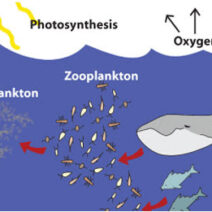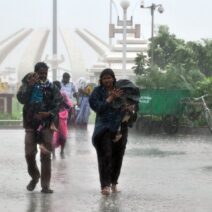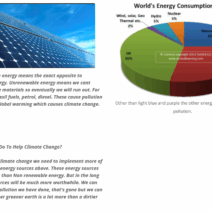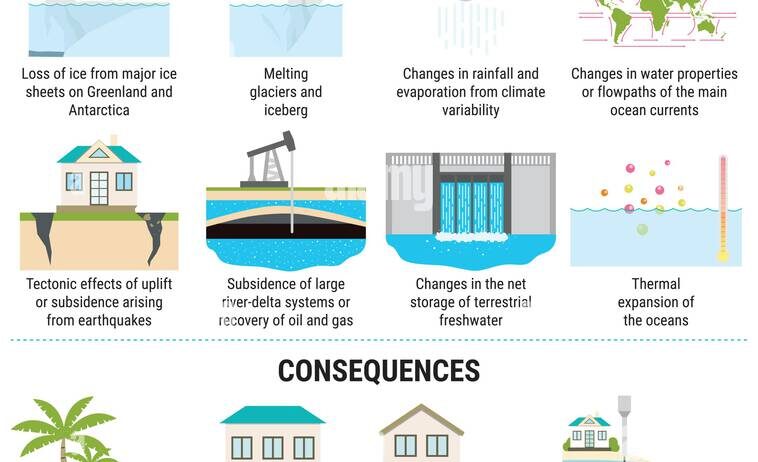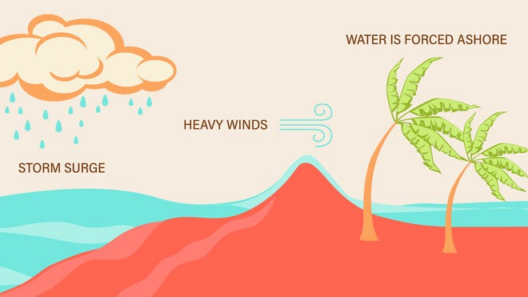As the world witnesses an unrelenting march of climate change, a conspicuous consequence emerges: the rise of sea levels. This alarming phenomenon, akin to an encroaching tide of uncertainty, is reshaping coastlines, threatening ecosystems, and destabilizing communities. The implications of rising ocean levels extend far beyond mere geography—they invoke profound socio-economic, environmental, and psychological ramifications. Understanding these consequences is essential as we navigate the intricacies of climate action.
Rising sea levels can be envisioned as a relentless wave, eroding the shores of both land and stability. This tide, driven by a combination of melting polar ice and thermal expansion of seawater, is affecting regions across the globe. While the gradual nature of this rise may suggest a benign threat, the reality is far more insidious. Each millimeter of increase represents a cascade of challenges that intensify with time.
Inhabitants of low-lying coastal areas find themselves perched precariously on the frontlines of this environmental crisis. The incremental ascent of the sea can transform coastal housing from secure real estate to vulnerable havens, exposed to the direct onslaught of saltwater intrusion. As tides begin to invade freshwater sources, agricultural prospects diminish, leading to a potential food security crisis. The sun-kissed farms that once thrived may transform into barren wastelands, compromising livelihoods. For these communities, the impacts are not merely theoretical; they are a stark reality that influences their everyday existence.
The socio-economic ramifications of rising sea levels reverberate through both vulnerable nations and robust economies alike. Insurance markets strain under the weight of increased claims, while governments are faced with the daunting task of managing the costs of mitigation and adaptation. Infrastructure begins to falter; roads, bridges, and utilities designed for a bygone equilibrium become beleaguered by inundation. Coastal cities, often hubs of cultural and economic vitality, must grapple with the existential threats posed by the encroaching deep. Economic displacement unfolds as properties are abandoned; the very fabric of community erodes.
As complete communities may face displacement, a wave of climate refugees appears on the horizon—individuals forced to abandon their homes in search of stability. This phenomenon marks a critical juncture in history, compelling nations to confront humanitarian obligations alongside environmental responsibilities. The rich tapestry of local cultures is at risk, as histories and identities intertwined with coastal landscapes are redefined by the relentless passage of rising waters.
The environmental consequences are multifaceted and severe. Coastal ecosystems, which serve as critical buffers against storms, begin to degrade as sea levels rise. Mangroves, salt marshes, and coral reefs, vital habitats that sustain biodiversity, find their existence under palpable threat. When these ecosystems falter, they no longer provide their invaluable services, such as carbon sequestration and shoreline protection. As species face habitat loss, the delicate balance of marine life teeters on the edge of disruption. The implications for the larger biosphere are profound, as the intricate web of life that connects all organisms begins to unravel.
Moreover, the psychological toll of rising sea levels cannot be overlooked. Think of the emotional weight that a community feels when threats of flooding, loss of home, and cultural disintegration loom over them. This psychological stress has repercussions that extend well beyond mere survival; it affects mental health, well-being, and the overall quality of life within these vulnerable populations. Fears and anxieties rooted in ecological changes cultivate a sense of hopelessness, dampening community spirit and complicating resilience efforts.
As the deluge of rising sea levels threatens our inhabited shores, we must consider innovative strategies for adaptation and resilience. These efforts can take a multitude of forms, from engineered solutions such as sea walls and levees to nature-based strategies that restore coastal ecosystems. These latter solutions—embracing the strength of nature to regain lost ground—encourage a remarkable synergy, where conservation and resilience coalesce. Rehabilitating wetlands and restoring mangroves act not only as formidable defenses but also as natural carbon sinks that combat climate change.
Mitigation is a cooperative endeavor and requires collective action. Adopting sustainable practices on both individual and societal levels can stem the tide of rising sea levels. Energy consumption reduction, transition to renewable resources, and robust support for governmental policy aimed at climate action are potent responses that wield influence at the heart of the issue.
The warnings of rising sea levels are not to be taken lightly. They echo through the corridors of time both as a cry of alarm and a call to duty. In the face of this existential threat, the convergence of community action, scientific acumen, and compassionate governance is essential for our shared destiny. The narrative need not conclude only with loss; rather, the potential for renewal and resilience must be harnessed. Collectively, we can reshape the future and redefine our relationship with the oceans, transforming peril into promise.
In navigating the uncharted waters of climate change and its consequences, we join in the pursuit of understanding: the essence of this journey is awareness, action, and an unwavering commitment to protecting our planet and its inhabitants. The waves may rise, but together, we can ensure that hope remains afloat.
